Review: Verdun 1916 Steel Inferno
Many of our readers know that I am fascinated by the Great War, it was an event that changed the world unlike any other and when the guns fell silent in 1918 society, maps, and military thought were almost unrecognizable from how they looked in 1914.
This passion has led me to help develop a bunch of games that cover the Great War. Back in January I caught a glimpse of a game called Verdun 1916 Steel Inferno (V1916SI) by the French gamers at the Fellowship of Simulations. I was impressed as most gamers are with the sheer beauty of the game and I made sure I was the first backer when the project hit Kickstarter on 21 February, the 104th anniversary of the start of the battle. When it comes to the Great War many gamers shy away because of the impression that the war was nothing but trench warfare. When it comes to board games about the war, they tend to represent the strategic level or the tactical level very well but never the operational level of warfare.
Some games have done a great job in capturing the campaign level however they are usually focused on the major offensives that had some type of breakthrough. Verdun was a slow grinding 10-month battle that was really a battle of annihilation with very little territory changing hands. I have not seen many games that capture this type of battle very well and V1916SI breaks that paradigm.
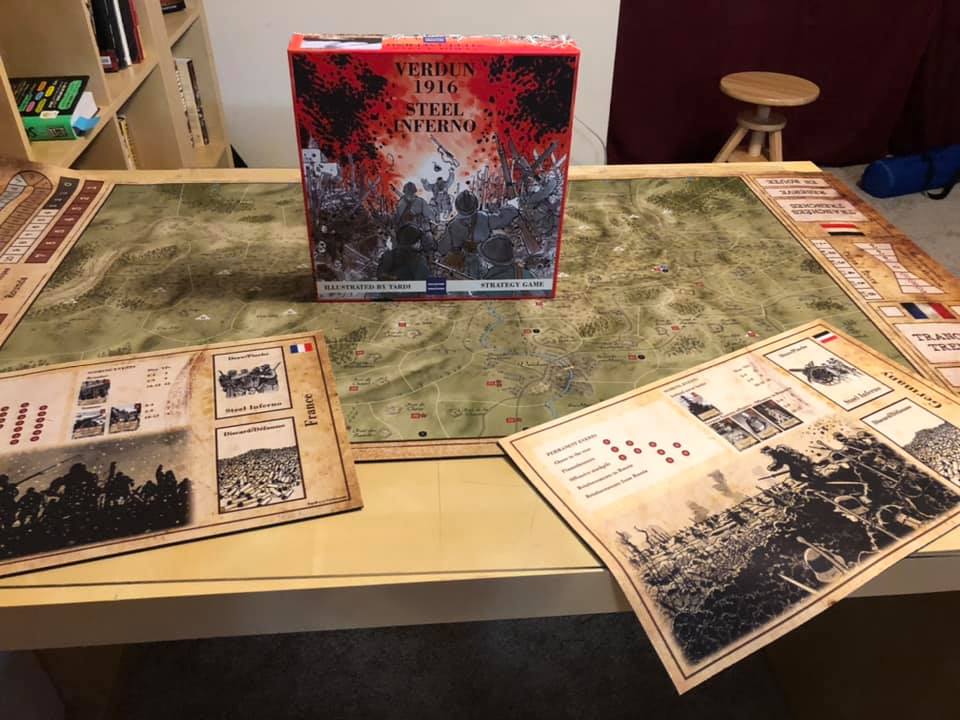 While I was initially struck by the beautiful map (which comes in both cardboard and neoprene)and the amazing artwork of I was very impressed by the game’s mechanics. They have done something that I really thought was impossible; to make Verdun a playable and fun game.
While I was initially struck by the beautiful map (which comes in both cardboard and neoprene)and the amazing artwork of I was very impressed by the game’s mechanics. They have done something that I really thought was impossible; to make Verdun a playable and fun game.
The game uses an action card mechanic that represents game events, barrages, and your ability to move and refresh your units. While some Grognards stuck in the 1970’s shy away from games that use cards, in V1916SI they are the heart and soul of the game and they seamlessly inject the overall strategic situation you find yourself in.
The full game is six turns with each turn lasting two months (except for turn 1) and each month has 7 rounds. As the game progresses the cards that you can play change in order to represent what is going on in the wider war. Events like US involvement, the Somme, Jutland and the overall momentum of the war affect gameplay.
In the first few turns, the German player can lay down massive bombardments and has the initiative to execute a massive attack while the French player has to wait until the later stages of the campaign to launch their counter-offensive. This slick mechanic really puts you into the shoes of the operational commanders at Verdun and forces you to give orders based of directives from Joffre and von Falkenhayn. This is done in a simple and invisible way that does not bog down the game at all.
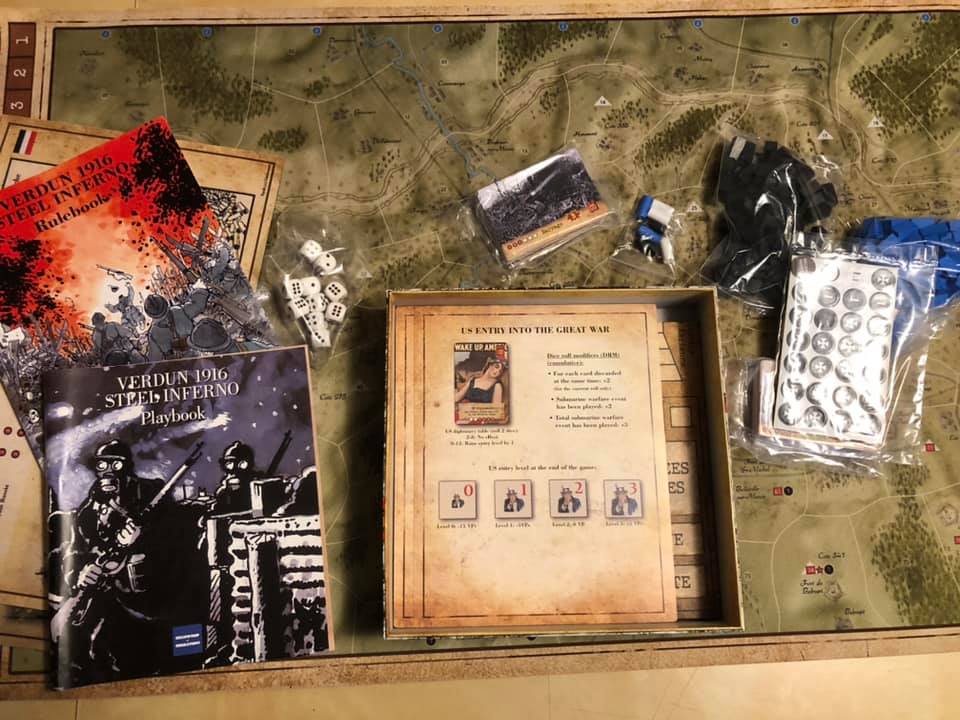
Attacking in the game is based on using those bombardment cards to pulverize a zone and then follow it up with an infantry attack. Just like the real war, the bombardment fails to neutralize your enemy, the follow-on attack is almost doomed.
For bombardments each card as a value that gives you the amount of d6’s you can roll. Each hit takes a fresh unit to spent or a spent unit to eliminated and if you have a fort or a trench in that zone, they can absorb hits with the remainder falling on your units.
Infantry combat is done by an algorithm, and if a fresh defending unit is in the zone after the artillery your attack will be hard-pressed to succeed. Friendly fire is also included in barrages where you did not have a unit in the zone prior to combat, which air superiority event cards can mitigate. As you can guess Germans get some barrages that have them roll as many as ten or eleven dice during the beginning of the game where the French do not get that firepower until they execute their counteroffensive later in the game.
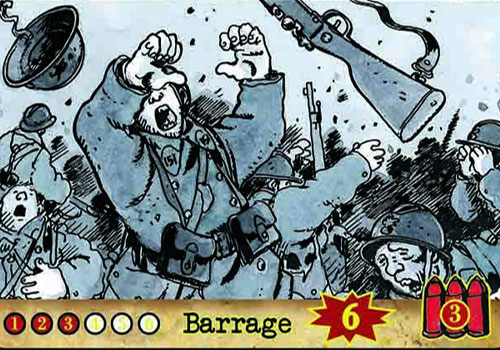
The game is all about getting Victory Points for capturing certain map zones and when you ask for reinforcements you are also giving your opponent VPs. Some event cards and the conditions they trigger also move the VP needle. I like this VP mechanic, does a player grind their enemy down so they need more units on the table or do you go for the zones that can automatically win the game? Each turn/round the calculus of this decision changes so you have to really think on how you manage the battle.
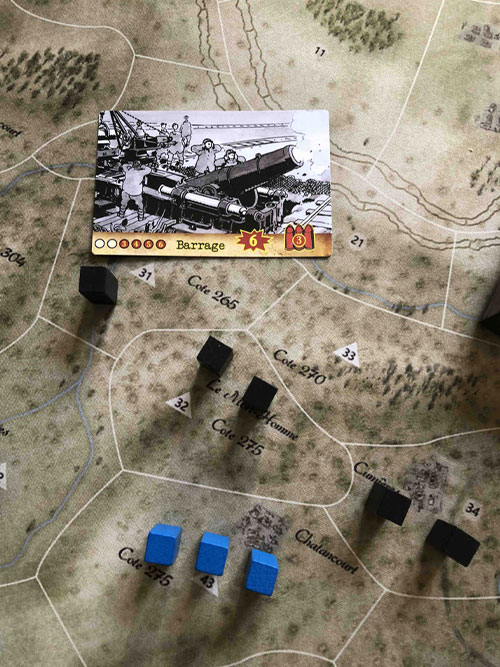
Another part of the game that may draw fear of those “stuck in the 70’s” grogs is that the units in the game are wooden blocks that can stand upright for fresh units and on their side for spent units. I know many gamers love specific unit counters because of a tie to a particular formation however that would take away from the experience the developer is creating for you here. So many units were fed into this battle, many of them were destroyed and reconstituted and sent right back into the front that keeping track of these units would bog down the game and it would not reflect the environment the battle was fought in.
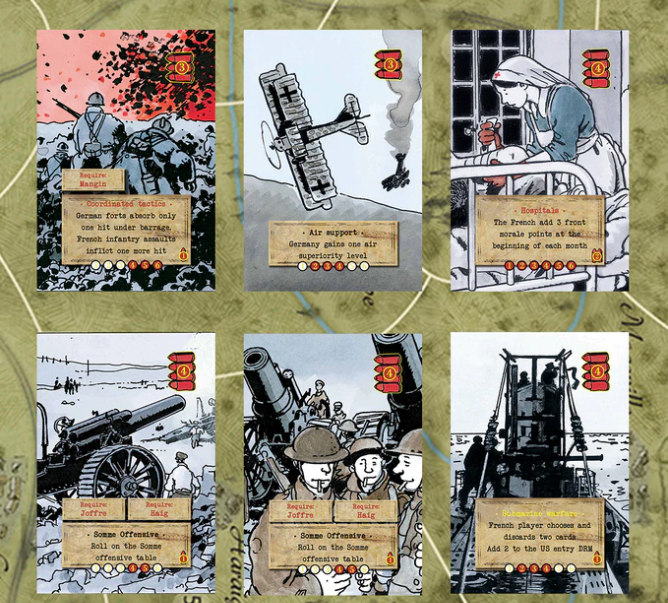
I have had the game rules since they were posted on Kickstarter in February. The game is easy to pick up and play. Despite reading the rules multiple times I did not get an appreciation of the mechanics until I played in person.
It has strategic elements akin to chess in that you have to think a few moves ahead. However, as the rounds are being played, you look to find an area of weakness in your enemies’ line and destroy it for later exploitation.
If you think that the French sit by passively and just take the pain in the early part of the game you would be mistaken. You need to really read the map and guess where the main German axis of attack is coming from and then place units to block exploitation. I loved playing the French in the first scenario, so many decisions to make such as where do you counter attack, where do you block, where do you build trenches.
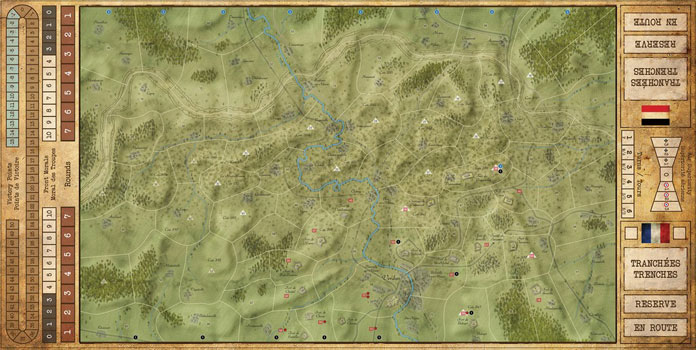 Based upon what I stated above I think you can now see how this game captures the reality of static warfare in a manner that makes for a fun and challenging game. The developers took some risks in making V1916SI, knowing that Great War games are not popular and by designing mechanics that I have not seen elsewhere. They ended up with a game that will impress even the most stubborn of greybeard grogs.
Based upon what I stated above I think you can now see how this game captures the reality of static warfare in a manner that makes for a fun and challenging game. The developers took some risks in making V1916SI, knowing that Great War games are not popular and by designing mechanics that I have not seen elsewhere. They ended up with a game that will impress even the most stubborn of greybeard grogs.
I’ve been to one world fair, a picnic, and a rodeo and I thought that a game of Verdun would be a stretch to pull off or so beer and pretzels that it would not be interesting. I was wrong and this game will appeal to the novice and grizzled veteran gamer alike and I suggest you check it out and get yourself copy before it sells out. The developers are also publishing solo rules and I tried out the first draft and the game plays well solo.
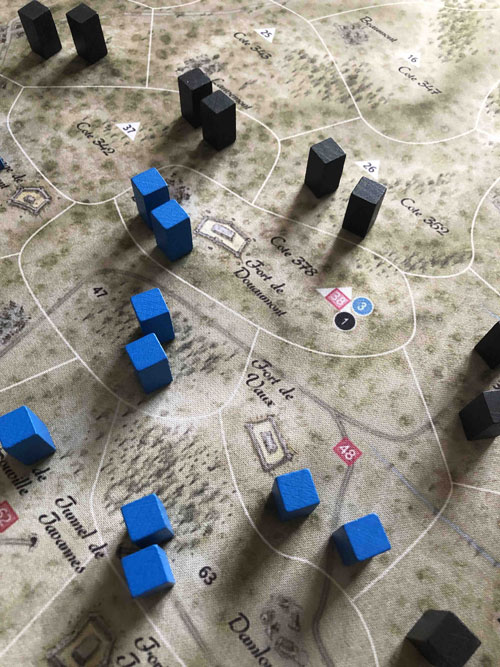
One thing I would like to point out is that the game hit Kickstarter in February 2020 and I got my copy of the game by the third week of June. When I first saw the estimated delivery time of May 2020, I felt it was a wish rather than an actual delivery date like so many other Kickstarter projects. With the game being made totally in France and the fact that COVID-19 locked that country down I doubted I would see this game until the fall, however they were able to deliver the game locally in May and all games were shipped by the end of the first week of June, so hats off to the development team.
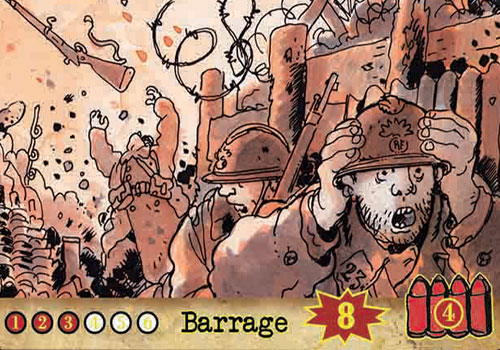
The developer told me that the next project in the series will cover the whole Western Front in 1918 with event cards that play politics amongst the Allies. Having pulled off a game like V1916SI I feel that this project slated for 2021 is a can’t miss game.
The game will be available directly from the and in North American from and by late July 2020.
If you have the game make sure you tell us what you think on You can also find videos on gameplay at BGG.
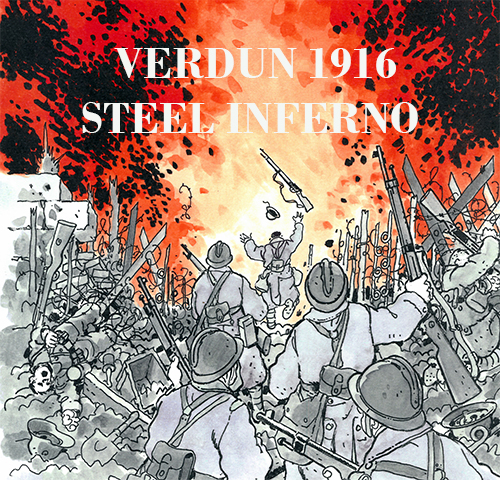

Great review. Thx